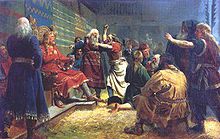Haakon the Good
- Haakon I redirects here. For the King of Sweden, see Haakon I of Sweden.
| Haakon I the Good | |
|---|---|
| King of Norway | |
 Hákon the Good, by Peter Nicolai Arbo | |
| Reign | 934–961 |
| Predecessor | Eric I |
| Successor | Harald II |
| Born | c. 920 Håkonshella, Hordaland, Norway |
| Died | 961 Håkonshella, Hordaland (fatally wounded in the Battle of Fitjar) |
| Burial | |
| Issue | Thora |
| Dynasty | Fairhair dynasty |
| Father | Harald I |
| Mother | Thora Mosterstong |
| Religion | Norse paganism, Christianity (Roman Catholic) |
Haakon I (Old Norse: Hákon Aðalsteinsfóstri, Norwegian: Håkon Adalsteinsfostre), (c. 920–961), given the byname the Good, was the third king of Norway and the youngest son of Harald I of Norway and Thora Mosterstang.[1]
Early life

King Harald determined to remove his youngest son out of harm's way and accordingly sent him to the court friend, King Athelstan of England. Haakon was fostered by King Athelstan, as part of a peace agreement made by his father, for which reason Haakon was nicknamed Adalsteinfostre.[2] The English king brought him up in the Christian religion.
On the news of his father's death King Athelstan provided Haakon with ships and men for an expedition against his half-brother Eirik Bloodaxe, who had been proclaimed king.
Reign
Upon his arrival back in Norway, Haakon gained the support of the landowners by promising to give up the rights of taxation claimed by his father over inherited real property. Eirik Bloodaxe soon found himself deserted on all sides, and saved his own and his family's lives by fleeing from the country. Eirik jad fled to the Orkney Islands and later to the Kingdom of Jorvik, eventually meeting a violent death on Stainmore, Westmorland, in 954 along with his son, Haeric.
In 953, Haakon had to fight a fierce battle at Avaldsnes against the sons of Eirik Bloodaxe. The battle is said to have been at the Bloodheights (Blodheia) which gained its name from this event. Haakon won the battle at which Eirik's son Guttorm died. One of Haakon's most famous victories was the Battle of Rastarkalv (near to Frei) in 955. By placing ten standards far apart along a low ridge, he to gave the impression his army was bigger than it actually was. He managed to fool Eirik’s sons into believing that they were out-numbered. The Danes fled and were slaughtered by Haakon’s army. The sons of Eirik returned in 957, with support from the Danish king, Gorm the Old. But again they were defeated by Haakon's effective army system.[3]
Haakon was frequently successful in everything he undertook except in his attempt to introduce Christianity, which aroused an opposition he did not feel strong enough to face. So entirely did even his immediate circle ignore his religion that Eyvindr Skáldaspillir, his court poet, composed a poem, Hákonarmál, on his death representing his welcome by his ancestors' gods into Valhalla.
Succession
Three of the sons of Eirik Bloodaxe (Gamle, Harold, and Sigurd) landed unnoticed on Hordaland in 961 and surprised the king at his residence in Fitjar. Haakon was mortally wounded at the Battle of Fitjar (Slaget ved Fitjar) after a final victory over Eirik’s sons. The King’s arm was pierced by an arrow and he died later from his wounds. He was buried in the burial mound (Håkonshaugen) in the village of Seim in Lindås municipality in the county of Hordaland. After Haakon's death, Harald Greycloak, third son of Eirik Bloodaxe, jointly with his brothers became kings of Norway. However, they had little authority outside Western Norway. Harald, by being the oldest, was the most powerful of the brothers. The succession issue was settled when he ascended the throne as Harald II. Subsequently the Norwegians were severely tormented by years of war. In 970, Harald II was tricked into coming to Denmark and killed in a plot planned by Sigurd Haakonsson's son Haakon Sigurdsson, who had become an ally of Harold Bluetooth.[4]
Modern references
- Haakon’s Park (Håkonarparken) in Fitjar is the location of a sculpture of Haakon the Good sculpted by Anne Grimdalen. The statue was erected during 1961 at the one thousand year commemoration of the Battle of Fitjar.
- Haakon I is a major character in Mother of Kings by the Danish-American writer Poul Anderson.
- Hakon is also the protagonist of Eric Schumacher's book God's Hammer.
Ancestors
| Family of Haakon the Good | |||||||||||||||||||||||||||||||||||||||||||||||||||||||||||||||||||||||||||||||||||||||||||||||||||||||||||||||||||||||||||||||||||||||||||||||||||||||||||||||||||||||||||||||||||||||||||||||||||||||||||||||||||||||||||||||||||||||||||||||||||||||||||||||||||||||||||||||||||||||||||||||||||||||||||||||||||||||||||||||||||||||||||||||||||||||||||||||||||||||||||||||||||||||||||||||||||||||||||||||||||||||||||||||||||||||||||||||||||||||||||||||||||||||||||||||||||
|---|---|---|---|---|---|---|---|---|---|---|---|---|---|---|---|---|---|---|---|---|---|---|---|---|---|---|---|---|---|---|---|---|---|---|---|---|---|---|---|---|---|---|---|---|---|---|---|---|---|---|---|---|---|---|---|---|---|---|---|---|---|---|---|---|---|---|---|---|---|---|---|---|---|---|---|---|---|---|---|---|---|---|---|---|---|---|---|---|---|---|---|---|---|---|---|---|---|---|---|---|---|---|---|---|---|---|---|---|---|---|---|---|---|---|---|---|---|---|---|---|---|---|---|---|---|---|---|---|---|---|---|---|---|---|---|---|---|---|---|---|---|---|---|---|---|---|---|---|---|---|---|---|---|---|---|---|---|---|---|---|---|---|---|---|---|---|---|---|---|---|---|---|---|---|---|---|---|---|---|---|---|---|---|---|---|---|---|---|---|---|---|---|---|---|---|---|---|---|---|---|---|---|---|---|---|---|---|---|---|---|---|---|---|---|---|---|---|---|---|---|---|---|---|---|---|---|---|---|---|---|---|---|---|---|---|---|---|---|---|---|---|---|---|---|---|---|---|---|---|---|---|---|---|---|---|---|---|---|---|---|---|---|---|---|---|---|---|---|---|---|---|---|---|---|---|---|---|---|---|---|---|---|---|---|---|---|---|---|---|---|---|---|---|---|---|---|---|---|---|---|---|---|---|---|---|---|---|---|---|---|---|---|---|---|---|---|---|---|---|---|---|---|---|---|---|---|---|---|---|---|---|---|---|---|---|---|---|---|---|---|---|---|---|---|---|---|---|---|---|---|---|---|---|---|---|---|---|---|---|---|---|---|---|---|---|---|---|---|---|---|---|---|---|---|---|---|---|---|---|---|---|---|---|---|---|---|---|---|---|---|---|---|---|---|---|---|---|---|---|---|---|---|---|---|---|---|---|---|---|---|---|---|---|---|---|---|---|---|---|---|---|---|---|---|---|---|---|---|---|---|---|---|---|---|---|---|---|---|---|---|---|---|---|---|---|---|---|---|---|---|---|---|---|---|---|---|---|---|---|---|---|---|---|---|---|---|---|
| |||||||||||||||||||||||||||||||||||||||||||||||||||||||||||||||||||||||||||||||||||||||||||||||||||||||||||||||||||||||||||||||||||||||||||||||||||||||||||||||||||||||||||||||||||||||||||||||||||||||||||||||||||||||||||||||||||||||||||||||||||||||||||||||||||||||||||||||||||||||||||||||||||||||||||||||||||||||||||||||||||||||||||||||||||||||||||||||||||||||||||||||||||||||||||||||||||||||||||||||||||||||||||||||||||||||||||||||||||||||||||||||||||||||||||||||||||
References
- ^ "Haakon I". The Free Dictionary.
- ^ "Hakon the Good". Catholic Encyclopedia. Retrieved 2007-02-18.
- ^ Haakon the Good and the Sons of Gunhild(Yesterday's Classics, LLC)
- ^ King Haakon The Good of Norway buried at Saeheim
External links
- The Saga of Haakon the Good
- This article incorporates text from a publication now in the public domain: Chisholm, Hugh, ed. (1911). Encyclopædia Britannica (11th ed.). Cambridge University Press.
{{cite encyclopedia}}: Missing or empty|title=(help)
